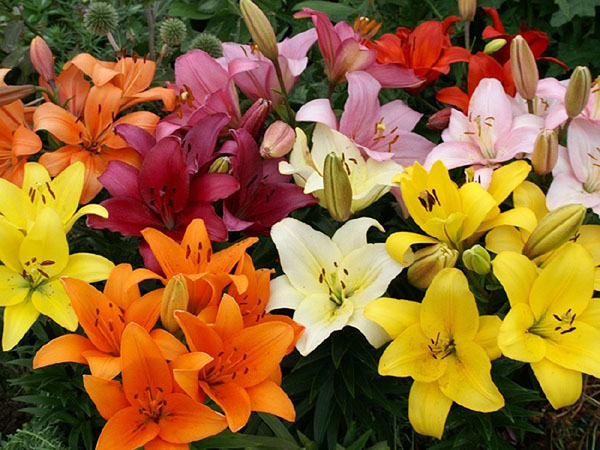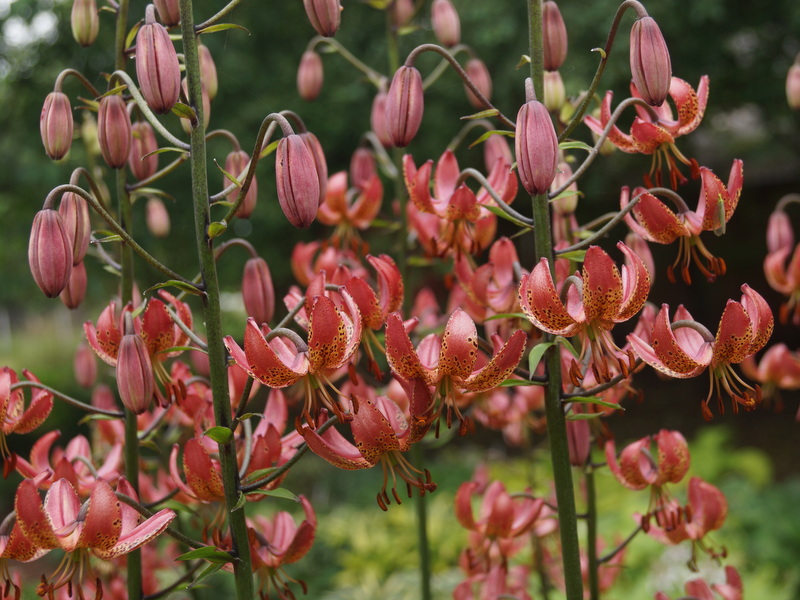Content:
Lily is a beautifully blooming perennial. Refers to bulbous crops that have long won the love of flower growers, it seems that there is not a single garden where these plants are not grown. Lilies are especially loved for their relative unpretentiousness and, of course, for the fact that you can admire the bright flowering for many years. There are an incredible number of varieties in total. The article will tell you everything about lilies: how to plant, dig up, care.
Varieties of varieties
According to the international classification, lilies are divided into 9 groups:
- Asian - the group includes more than 5 thousand varieties. They are winter-hardy, unpretentious. There is no aroma.
- Curly (martagon hybrids) - durable, frost-resistant. The name was given for the shape of the inflorescences. One stem can have up to 30-50 flowers, so they are called bush flowers. This group includes about 200 varieties.
- American. A total of 140 varieties are known. They are light-requiring. The flowers are turbid with a characteristic speck.
- Longiflorum (longiflorum) have an elongated shape, usually white and rich in aroma.
- Tubular. The flowers have a gramophone shape and a strong aroma. Often damaged by recurrent frost.
- Oriental (oriental hybrids). This group accounts for approximately 10% of the total assortment of lilies. They begin to wake up later than others in the spring and therefore are not afraid of return frosts.
- Interspecific hybrids - fruits of labor of breeders with the best qualities of parental varieties. The size of the flowers is large.
- Wild lilies - natural varieties. They are often used by breeders to create new varieties.
Lilies: planting and care in the open field
For planting flowers, beds are chosen where water does not stagnate. This is necessary to prevent rotting of the bulbs. Lilies prefer slightly alkaline and slightly acidic soil. In acidic soil, varieties of the eastern group can be grown.
When to plant lilies in open ground in the Moscow region
The optimal planting time for lilies is autumn. At this time, they have time to take root and winter well, and the next season they bloom earlier.
When to plant lilies in the Moscow region in the fall, in the Urals and Siberia
In the Moscow region and the Moscow region, flowers are planted from early October to early November.
The Urals have a harsher climate, so it is advisable to plant lilies in the period from early September to early October.
In Siberia, taking into account the difficult climatic conditions, the landing is carried out in August or September.
What lilies are better to plant in the suburbs
Growing lilies in the open field in the Moscow region will be successful if you choose the most suitable species and varieties. The most persistent and hardy are Asian hybrids (Montreux, Yeti, Aelita, Lova Rose, Pearl Justin, Red Velvet). Recommended varieties of LA hybrids: Top Gun and Samur, Indian Diamond, Daytona, Fray, Golden Stat, Original Live, Bright Diamond.From March a race of hybrids: Redman, Orange Marmalade, PinkAttraction, Arabian Night, Manitoba Fox, Claude Shride.
Planting and leaving
Proper planting and caring for lilies is the basis of their magnificent flowering. For the prevention of various diseases, before sending to the ground, the bulbs are treated in potassium permanganate.
The cutting depth must be equal to the height of 3 bulbs. A layer of sand is poured onto the bottom of the hole. The roots of the bulb are gently straightened. The well is watered abundantly. To prevent the roots from drying out, mulching is performed. Hay or sawdust is suitable for these purposes.
For lush flowering during the season, lilies are recommended to be fed with complex fertilizers and ash. Humus is a good top dressing.
When dry weather is established, flowers need to be adequately watered.
Lilies are transplanted every 5-6 years, otherwise the flowers are chopped, and the inflorescences lose their splendor.
Major pests: lily beetle and lily fly. For the fight use drugs thunder, grizzly, fly eater.
In the fall, the stems need to be cut. Remaining dry, they can become a conductor of cold to the bulb in winter.
All lilies are garden flowers, but they can be grown not only in the country, but also at home. For this, oriental, Asian hybrids, long-flowered lilies, as well as golden, beautiful, dwarf, royal are suitable. Also indoor lilies include amaryllis and hippeastrum, similar to water lilies. Potting is usually done in early spring.
When to transplant lilies after flowering in the suburbs
In August, you can start transplanting lilies in the Moscow region. After the end of flowering, the plant is given a rest for 1-1.5 months and transcends the procedure. Moreover, it is often combined with dividing the bush and other breeding techniques.
Flower propagation
The easiest way is to divide the bush. But not all varieties form many bulbs. The second popular method is reproduction by children. Children are separated in a month and a half after flowering, since by this time they are gaining the greatest strength. You can also propagate lilies with bulbs. These are airy bulbs that form right in the axils of the leaves on the stem. With this method of reproduction, the plant will bloom for 3 years.
From the description above, it can be seen that lilies are quite unpretentious in care. If you choose the collection well, then you can admire the delightful flowering from June to September.














